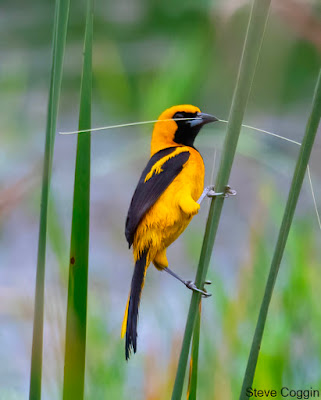 |
| A Swainson's Thrush (Catharus ustulatus) peers down from its leafy perch on fall migration. Rowan County, North Carolina. |
The days are getting longer, and migrant birds are returning to our area. Thrushes are some of my favorites and many are winging their way north from the tropics and will be here soon. Others stay in the Southeast year-round and one spends the whole winter with us. Thrushes are classified in the family Turididae which includes new world thrushes, Eastern Bluebirds and American Robins.
 |
| Wood Thrush (Hylochicla mustelina). Mecklenburg County, North Carolina. |
The iconic thrush that will be arriving soon is the Wood Thrush (Hylochicla mustelina). This medium sized songbird winters from southern Mexico to Panama and breeds throughout much of North American. The head and back are reddish-brown while the breast and belly are white with bold black spots. Male Wood Thrushes have one of the most beautiful songs of all North American birds. The ringing, flute-like song sounds through the forest and is produced by the Wood Thrush’s unique voice box, the syrinx. The syrinx has two parts so the Wood Thrush can sing an unaccompanied duet. The Wood Thrush is a Near Threatened species whose population has been reduced by half since the 1960s. Fragmentation of the forest where they breed in North American have made Wood Thrushes more vulnerable to Brown-headed Cowbirds (Molothrus ater) that are nest parasites. The Brown-headed Cowbirds lay their eggs in the Wood Thrush nest and the larger Cowbird chick outcompetes the Thrush chicks for food. Habitat loss on their wintering grounds has also reduced their numbers but shade grown coffee farms in Central America provide good wintering habitat.
 |
| Swainson's Thrush feeding on Red Mulberry (Morus rubra) during spring migration. Mecklenburg County, North Carolina. |
 |
| Hermit Thrush (Catharus guttatus). Rowan County, North Carolina. |
 |
| Hermit Thrush showing its reddish tail. Rowan County, North Carolina. |
 |
| Veery (Catharus fuscescens). Mecklenburg County, North Carolina. |
The Veery (Catharus fuscescens) is the smallest and palest of the Catharus thrushes. Veeries are cinnamon-brown above with small, light spots on the throat and upper breast. They breed on the border lands of the United States and Canada, and south along the Rockies and Appalachian Mountain chains. Veeries winter in Brazil.
 |
| Male Eastern Bluebird (Sialia sialis). Rowan County, North Carolina. |
 |
| Female Eastern Bluebird. Mecklenburg County, North Carolina. |
 |
| Male Eastern Bluebird at nest. Mecklenburg County, North Carolina. |
 |
| Juvenile Eastern Bluebird. Rowan County, North Carolina. |
The Eastern Bluebird (Sialia sialis) is a common permanent resident in much of eastern North America, and south through the mountains of Mexico to Central America. The northern-most populations migrate south for the winter. Male Eastern Bluebirds are brilliant blue on the crown of the head, wings, back and tail. They have a white belly and a reddish-orange breast. Females are only slightly less colorful with muted blue on their head and back. Juvenile Eastern Bluebirds have spots on the breast denoting their thrush heritage. Eastern Bluebirds naturally nest in old woodpecker holes and will happily use man-made boxes.
 |
| Male American Robin (Turdus migratorius). Rowan County, North Carolina. |
American Robins (Turdus migratorius) are the largest thrushes in eastern North America. While the genus Turdus invites snickers from middle school boys, the word is Greek for thrush. American Robins were named by early English settlers of North America because they resembled the European Robin, although the European bird is classified in an entirely different family. The American Robin is one of the most recognizable of our birds with the dark brown or black head, dark back and tail and its brick red breast. The coloration of the males is more intense than that of the females and the immature birds have spots on the breast. American Robins eat fruits, insects and are a common sight feeding on worms in suburban lawns.
 |
| Red-legged Thrush (Turdus plumbeus) a vagrant thrush from Cuba. Key West Tropical Forest and Botanical Garden, Florida. |
The Red-legged Thrush (Turdus plumbeus) is a native of the islands of the Greater Antilles and Bahamas but sometimes a stray will reach Florida. In December 2020, at the height of the COVID 19 pandemic, one of these wayward Red-legged Thrushes showed up near Key West, Florida. Diane and I went looking for this rare bird in the uncertain world of no vaccines, masks and closed businesses. It was reported at the Key West Tropical Forest and Botanical Garden on Stock Key and luckily the garden was open to the public. The friendly folks at the ticket counter looked at our binoculars and camera and knew why we had come. They directed us to a fig tree near the entrance to the garden and there, up on a limb near the crown of the tree was the Red-legged Thrush. The bird was dark gray with white on the chin and a black throat. It had orange on the belly, red eye rings and bright red legs. There are several subspecies of Red-legged Thrush each on its own island. The color pattern on this bird told us it had come from Cuba, only about 100 miles away.
Thrushes have a marvelous variety of colors, from the subdued
shading of Swainson’s Thrushes to the exuberance of the Eastern Bluebirds. Their songs
are musical and varied, and many species come right into our yards. Soon the Hermit Thrushes will leave us to fly
north to breed and the Wood Thrushes will return from the south and nest in our
forests. Swainson’s Thrushes and Veeries
will pass through, and the American Robins and Eastern Bluebirds will begin
nesting in our neighborhoods. I am pleased to have these thrushes (spending time with us.
 |
| American Robin eating Crab Apples (Malus sp.). Mecklenburg County, North Carolina. |













